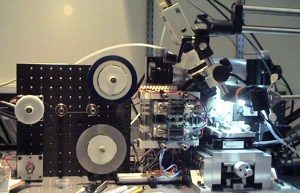Connectomics: Mapping The Brain
 Using automated technology to derive neural maps from brain tissue, Harvard researchers are in the early stages of an effort to map the human brain. Eventually, the researchers hope to map every synapse in the human brain and produce a “connectome.”
Using automated technology to derive neural maps from brain tissue, Harvard researchers are in the early stages of an effort to map the human brain. Eventually, the researchers hope to map every synapse in the human brain and produce a “connectome.”
“You’re going to see things you didn’t expect,” said Jeff Lichtman, a Harvard professor of molecular and cellular biology. “It gives us an opportunity to witness this vast complicated universe that has been largely inaccessible until now.”
The effort is part of a new field of scientific research called connectomics. The field is so new that the first course ever taught on it recently ended at MIT. It is to neuroscience what genomics is to genetics. Where genetics looks at individual genes or groups of genes, genomics looks at the entire genetic complement of an organism. Connectomics makes a similar jump in scale and ambition, from studying individual cells to studying swaths of the brain containing millions of cells. A full set of images of the human brain at synapse-level resolution would contain hundreds of petabytes of information, or about the total amount of storage in Google’s data centers, Lichtman estimates. [From WIRED: Mapping the Most Complex Structure in the Universe: Your Brain by Alexis Madrigal.]
The key tool to be used in the mapping process is the automatic tape-collecting lathe ultramicrotome (ATLUM) – a sort of ultrafine bologna-slicer that makes exceptionally thin tissue slices and runs continuously for greater speed. The tissue is then magnified using electron microscopy to image individual cells. A key part of the process in Harvard’s effort will be to automate the organization and analysis of these images.
This work is a long way from producing a brain map that might be used in neuroeconomics or neuromarketing studies, but it’s exciting to see researchers embarking on this kind of effort. One thing I wonder about is how different our brains are at the level of detail proposed for the study. The analogy isn’t entirely apt, but is it possible that one might be creating a detailed map of Cleveland to better understand traffic patterns in Dallas? Obviously, our brains all share basic structural similarities, but recent work in neurogenesis, brain plasticity, and even cultural differences suggest that as brain maps get more granular individual differences will become more evident. Still, the resolution of the proposed map would be far, far greater than that offered by tools like fMRI, and such a map will undoubtedly yield many new insights if it can actually be created.
